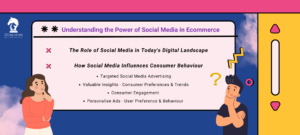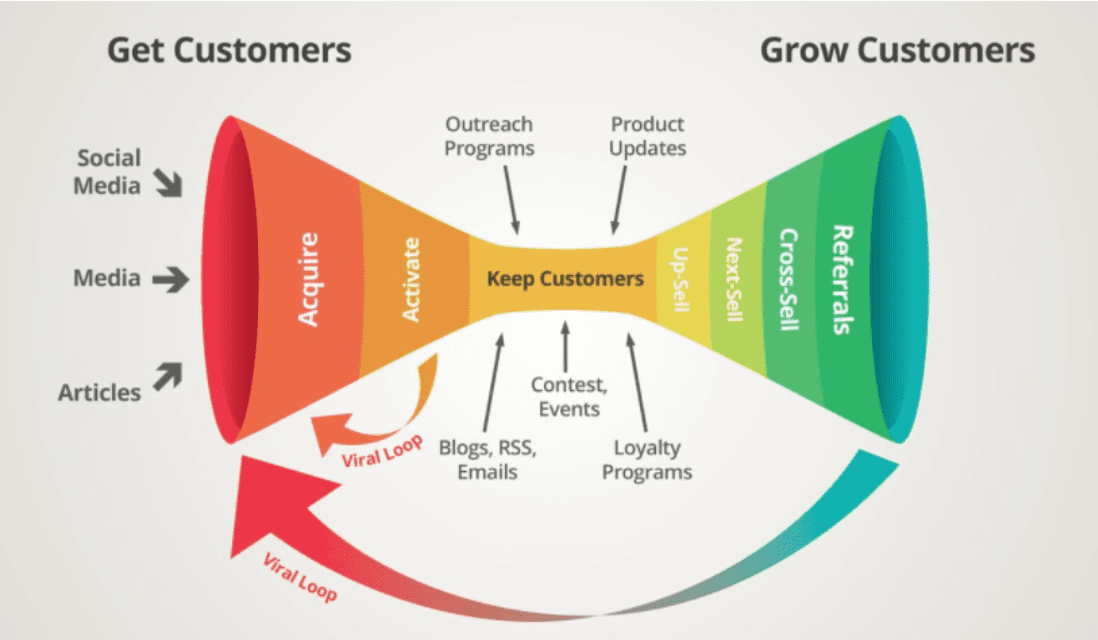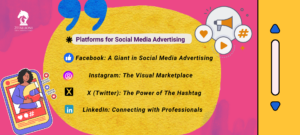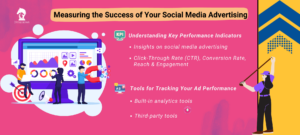Content
SHARE

Social media has become integral to our daily lives within the modern digital ecosystem. From connecting with friends and family to sharing personal experiences, social media platforms offer a wealth of opportunities for interaction and engagement. But did you know that social media can also be a powerful tool for businesses, especially those in the ecommerce industry? In this article, we will explore how social media advertising can help amplify your reach and boost your ecommerce success.

Understanding the Power of Social Media in Ecommerce
With billions of active users worldwide, platforms like Facebook, Instagram, Twitter, and LinkedIn provide businesses with an unprecedented opportunity to connect with their target audience on a personal level. Ecommerce businesses can reach potential customers, build brand awareness, and ultimately drive sales by harnessing the power of social media advertising.
The Role of Social Media in Today’s Digital Landscape
Social media has become a significant part of our daily routine. It is where people stay informed, entertained, and connected with others. From scrolling through news feeds to engaging with content, social media platforms have created a virtual space where individuals spend significant time. As an ecommerce business, tapping into this massive market can greatly impact your reach and visibility.
How Social Media Influences Consumer Behaviour
Social media has become a powerful influencer when it comes to consumer behaviour. People tend to trust the recommendations and opinions shared by their peers on social media platforms. By leveraging targeted social media advertising, ecommerce businesses can tap into this ripple effect and create brand advocates who can drive sales through word-of-mouth recommendations. Additionally, social media platforms allow businesses to tailor their ads based on user preferences and behaviours, ensuring that their message reaches the right audience at the right time.
Furthermore, social media platforms provide ecommerce businesses with valuable insights into consumer preferences and trends. By analysing the data collected from user interactions, businesses can gain a deeper understanding of their target audience’s needs and wants. This information can then be used to develop more effective marketing strategies and create products or services that resonate with customers.
Moreover, social media platforms offer ecommerce businesses the opportunity to engage directly with their customers. Through comments, direct messages, and live chats, businesses can provide personalised customer support, answer queries, and address concerns in real-time. This level of interaction not only strengthens the relationship between the business and the customer but also enhances the overall customer experience.
Platforms for Social Media Advertising
When it comes to social media advertising, there is no shortage of platforms to choose from as each platform offers its own unique set of features and advantages for ecommerce businesses. Let’s take a closer look at some of the most popular ones:
Facebook: A Giant in Social Media Advertising
With over 2.8 billion monthly active users, Facebook is undoubtedly a powerhouse in the world of social media advertising. From highly targeted ads to engaging content formats, Facebook offers an array of tools alongside with features that assist ecommerce businesses to connect with their target audience and drive conversions. Whether you are looking to increase brand awareness, generate leads, or boost sales, Facebook’s advertising platform provides a comprehensive solution.
Instagram: The Visual Marketplace
As a visually-oriented platform, Instagram offers ecommerce businesses a unique opportunity to showcase their products in a visually appealing way. With over 1 billion monthly active users, Instagram’s highly engaged community provides businesses with a platform to build brand loyalty and drive sales. From influencer marketing to shoppable posts, there are plenty of advertising options available on Instagram to amplify your reach and increase conversions.
X (Twitter): The Power of The Hashtag
Known for its real-time nature and concise content format, X allows businesses to connect with their audience in a direct and immediate way. With its extensive use of hashtags, X offers ecommerce businesses the opportunity to join relevant conversations, engage with customers, and drive traffic to their website. By leveraging X’s advertising platform, businesses can amplify their reach and tap into a global audience.
LinkedIn: Connecting with Professionals
Unlike other social media platforms, LinkedIn focuses specifically on professional networking and career development. For ecommerce businesses targeting professionals or B2B customers, LinkedIn’s advertising options provide a unique opportunity to connect with decision-makers and industry influencers. From sponsored content to targeted ads, LinkedIn offers a range of tools to help you reach your ideal audience and drive business growth.
But what about other platforms that may not be as well-known? One such platform is Pinterest. With its focus on visual discovery and inspiration, Pinterest offers ecommerce businesses the opportunity to showcase their products in a way that resonates with users who are actively seeking new ideas and products. With over 450 million monthly active users, Pinterest provides a unique space for businesses to tap into a highly engaged audience and drive traffic to their websites.
Another platform that shouldn’t be overlooked is Snapchat. With its emphasis on ephemeral content and creative storytelling, Snapchat allows ecommerce businesses to connect with a younger demographic in a fun and engaging way. With over 500 million monthly active users, Snapchat offers businesses the chance to reach a vast audience and create memorable brand experiences through filters, lenses, and sponsored content.
So, when it comes to social media advertising, it’s important to consider not only the well-established platforms like Facebook, Instagram, X, and LinkedIn, but also explore the opportunities that platforms like Pinterest and Snapchat can offer. By diversifying your advertising efforts across multiple platforms, you can maximise your reach and connect with a wider range of potential customers.
Crafting the Perfect Social Media Ad
Now that we understand the power of social media advertising and the different platforms available, let’s explore the key elements of crafting an effective social media ad.
Social media advertising has revolutionised the way businesses connect with their target audiences. With the ability to reach millions of users worldwide, it offers a cost-effective and efficient way to promote products and services. However, to truly maximise the impact of your social media ads, it is essential to pay attention to the finer details.
Identifying your Target Audience
One of the first steps in creating a successful social media ad is identifying your target audience. By understanding the demographics, interests, and behaviours of your ideal customers, you can tailor your ad messaging and content to resonate with them. Utilise the targeting options provided by the social media platforms to ensure that your ads reach the right audience.
Moreover, conducting thorough market research can provide valuable insights into consumer preferences and trends, allowing you to refine your targeting strategy further. By delving deep into the psyche of your target audience, you can create ads that not only capture attention but also drive meaningful engagement.
Creating Engaging Content
Engaging content is crucial to capturing the attention of your target audience. Whether it’s a compelling headline, eye-catching visuals, or a captivating video, your content should be designed to stand out and spark curiosity. Use storytelling techniques and emotional appeal to create a connection with your audience and encourage them to take action.
Furthermore, incorporating user-generated content and interactive elements can enhance the overall appeal of your ads, fostering a sense of authenticity and trust among consumers. By fostering a two-way conversation with your audience, you can cultivate a loyal following and drive long-term brand loyalty.
Utilising the Right Call-To-Action
A call-to-action (CTA) is a critical component of any social media ad. Your CTA should clearly communicate the desired action you want your audience to take, whether it’s visiting your website, making a purchase, or signing up for a newsletter. Be clear and concise in your messaging, and make it easy for users to understand how to take the next step.
Moreover, A/B testing different CTAs can provide valuable insights into which prompts resonate best with your audience, allowing you to refine your approach and maximise conversions. By continuously monitoring and optimising your CTAs, you can ensure that your social media ads deliver the desired results and drive measurable business growth.
Measuring the Success of your Social Media Advertising
Once you’ve launched your social media ad campaign, it’s essential to track and measure its success. Here are some key performance indicators (KPIs) to consider:
Understanding Key Performance Indicators
Key performance indicators (KPIs) provide valuable insights into the effectiveness of your social media advertising efforts. Metrics such as click-through rate (CTR), conversion rate, reach, and engagement can help you gauge the impact of your ads and make data-driven decisions to optimise your campaign.
Tools for Tracking your Ad Performance
To track and analyse the performance of your social media ads, there are various tools available. Social media platforms like Facebook and Instagram provide built-in analytics tools that give you detailed insights into your ad’s performance. Additionally, third-party tools like Google Analytics can provide a holistic view of your ecommerce website’s traffic and conversions driven by social media advertising.
In conclusion, social media advertising presents a significant opportunity for ecommerce businesses to amplify their reach and drive sales. By understanding the power of social media, leveraging the right platforms, crafting engaging ads, and measuring their success, businesses can tap into the vast potential of social media advertising and achieve ecommerce success.
Social Media Advertising & Ecommerce FAQs
What are the key benefits of social media advertising for eCommerce?
Key benefits include increased brand visibility, targeted reach to specific demographics, higher engagement rates, and direct opportunities to drive sales through accessible shopping features embedded in social platforms.
How can eCommerce businesses optimise their social media ads?
Optimising social media ads involves using high-quality visuals, crafting compelling ad copy, segmenting audiences for personalised targeting, testing different ad formats, and continuously analysing performance metrics to refine strategies.
What are some effective social media platforms for eCommerce advertising?
Effective platforms for eCommerce advertising include Facebook and Instagram for their extensive user base and advanced targeting options, Pinterest for its focus on visual discovery, and TikTok for reaching younger demographics.
How should eCommerce businesses measure the ROI of their social media advertising?
Measuring ROI involves tracking metrics such as click-through rates, conversion rates, cost per acquisition, and overall sales generated directly from ad campaigns. Additionally, analysing customer engagement and retention can provide insights into the long-term value of social media advertising efforts.
















